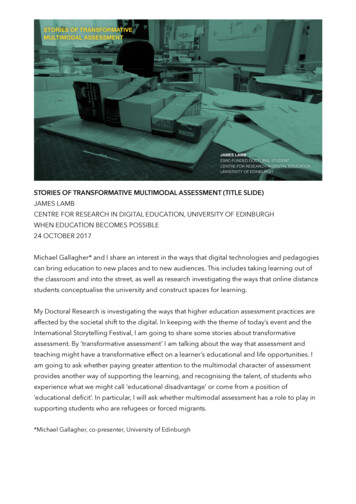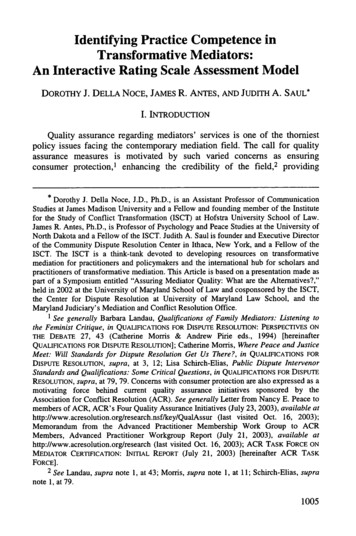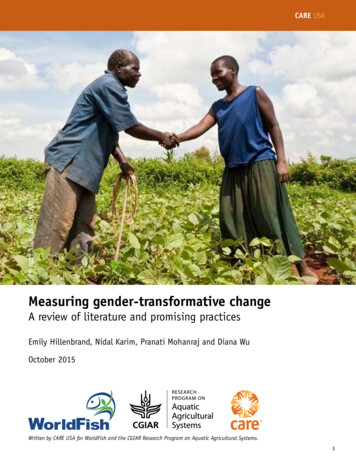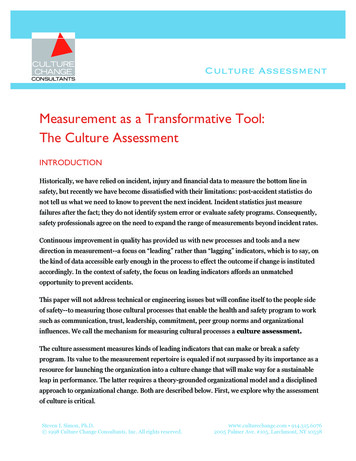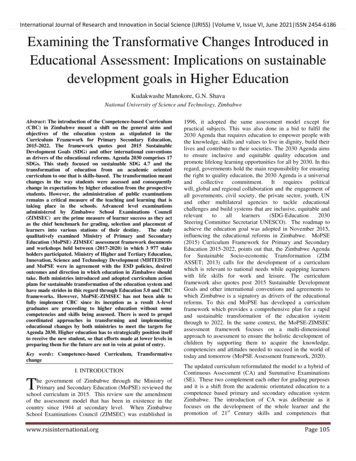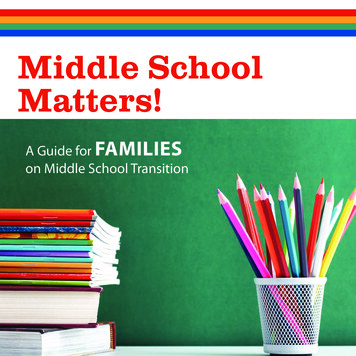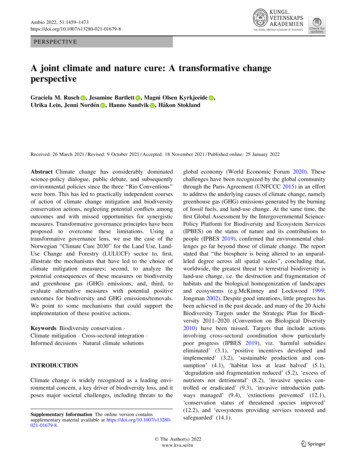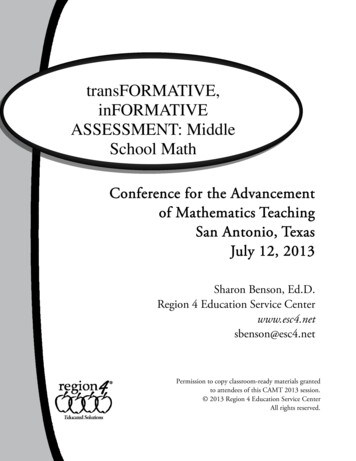
Transcription
transFORMATIVE,inFORMATIVEASSESSMENT: MiddleSchool MathConference for the Advancementof Mathematics TeachingSan Antonio, TexasJuly 12, 2013Sharon Benson, Ed.D.Region 4 Education Service Centerwww.esc4.netsbenson@esc4.netPermission to copy classroom-ready materials grantedto attendees of this CAMT 2013 session. 2013 Region 4 Education Service CenterAll rights reserved.
Handouts will be available online until July 31, 2013.http://www.esc4.net-Click on Services-Click on Instructional Services-Click on Mathematics-Click on Professional Development .facebook.com/R4mathhttp://www.twitter.com/R4math
http://learninglaffs.blogspot.com/
What makes formative assessment special?Clarifying and sharing learning intentions and criteriafor successEngineering effective classroom discussions, questions,Providing feedback that moves learners forwardand learning tasks that elicit evidence of learningActivating students as instructional resources for oneActivating students as the owners of their own learninganotherWiliam, D. (2007). Keeping learning on track: Classroom assessment and the regulation of learning. In F.K. Lester, Jr., (Ed,), Second Handbook of Researchon Mathematics Teaching and Learning. Reston (pp. 1051-1098). Reston, VA: National Council of Teachers of Mathematics.
Adjustment Triggers
ModerateWeakStrongfeedback“knowledge of results”“knowledge of correct results”
Task AHow can you best describe this pattern mathematically?How many rectangles would be in the seventh shape? Thirteenth shape? nth shape?Task BMalcolm has 22 in his bank at home. He plans to add 1 each week to this savings. Yesenia has 43 in her bank at home. She plans to add 7 each week to her savings. After how many weekswill Yesenia have saved four times as much money as Malcolm has saved at that same time? Howmuch should Malcolm save each week if he wants to have twice as much savings as Yesenia after 8weeks?Task AHow can you best describe this pattern mathematically?How many rectangles would be in the seventh shape? Thirteenth shape? nth shape?Task BMalcolm has 22 in his bank at home. He plans to add 1 each week to this savings. Yesenia has 43 in her bank at home. She plans to add 7 each week to her savings. After how many weekswill Yesenia have saved four times as much money as Malcolm has saved at that same time? Howmuch should Malcolm save each week if he wants to have twice as much savings as Yesenia after 8weeks?
Strategy HarvestBelow are three strategies to solve the problem. Choose the one you would use or solve it usingyour own strategy. Circle all of the strategies that could be used to solve thisproblem. Is one way better than the others? Why?
Formative Assessment Strategies3-2-1Signal and Action Responses(Greenstein, 2010) Students write three key terms related to whatthey have learned.Students write two questions they have aboutwhat they have learned.Students write one way that they can see them‐selves applying what they have learned.(Chapman and King, 2012) Comments-Only MarkingCoding (Keeley and Tobey, 2011)Use green to highlight what you know the best.Use yellow to highlight what you know “okay.”Use pink to highlight what you can’t remember. Use a star to indicate what you know the best.Use a check mark to indicate what you know“okay.”Use a question mark to indicate what you can’tremember. ORChoose one action that best represents one’s ap‐propriate knowledge base.Example: Point to your brain. I know it. Point to your eyes. I have seen this before. Cover your ears. I have never heard of it!Use prompts and codes to provide feedback:SC: Meets criteria for success.UP: Unclear processCE: Computation errorRT: Replace term. Locate the incorrect use of amath term and replace it with a correct term.NC: Number correct. You correctly answered thisnumber. Determine which are correct and incor‐rect. For the incorrect problems, identify and fixyour mistake.Students who received comments only did better thanstudents who received right/wrong with a grade andthose who received both.Terminology Inventory Probe(Keeley and Tobey, 2011)TermI have never heard of this.I have heard of this but I’m not sure what itmeans.I have some idea what it means.I can clearly know what it means and candescribe it:Thinking Exit SlipsChoose the sentence starter that best describes yourthinking today and complete it. I got stuck I figured out I didn’t expect I will understand this better if I . I wish I could.
Formative Assessment StrategiesFold and PassPoint of Most Significance/Muddiest Point(Keeley and Tobey, 2011) Students are asked to individually complete anassessment without placing their names on thepaper.After students have completed the probe, theyfold the paper and exchange with3‐4 other students in the class.The teacher then has students look at the paperthey are holding and asks questions. The studentsanswer based on the information on the paperthey are holding. (ex: How many students havepapers with as an answer?)(Keeley and Tobey, 2011) Agree-DisagreeTraffic Light Dots(Keeley and Tobey, 2011)(Keeley and Tobey, 2011)Multiplying a number by a fraction makes a largernumber.AgreeDisagreeIt depends on Not sureMy thoughts: I can find out by. After a student independently completes a taskthey are given a written example of multiple waysto solve the problem.The student identifies the strategy that mostclosely matches their strategy.The student works to write an explanation of theother strategies presented and why they alsowork.This strategy allows students to self assess theirwork and ask for feedback from other classmatesor the teacher.After completing an assignment student placescolored sticky dots in the margin for each question. Green—I understand this problem! Yellow—I am not sure how I did Red—I really could use some help The teacher can then provided feedback or pairstudents for conversations.Collaborative Clued CorrectionsStrategy Probe(Keeley and Tobey, 2011) Students are asked to reflect on the lesson andidentify one of the following: Point of Most Significance (POMS)—thepoint that contributed the most to theirlearning Muddiest Point—the most difficult orconfusing part of the lessonThe teacher collects the responses and makeschanges to the next day’s instruction includingclarifying and adding more emphasis to key points.(Keeley and Tobey, 2011) Students complete selected response or short an‐swer questions.The teacher selects papers that include incorrector partially correct responses.The teacher provides feedback on the number andtype of errors as well as areas for improvement.These are the “clues.”The sample set of papers with clues are returnedto small groups of students who work to see outerrors and fix them.
ReferencesINFORMative Assessmentby Jeane Joyner and Mari MuriWhat Teachers REALLY need toknow about Formative Assessmentby Laura GreensteinTransformative Assessmentby W. James PophamDifferentiated Assessment StrategiesBy Carolyn Chapman and Rita KingMathematics Formative AssessmentBy Page Keeley and Cheryl RoseTobeyClassroom DiscussionsBy Anderson, Chapin, andO’ConnorFormative AssessmentResearch Clip by NTCMFive “Key Strategies” for EffectiveFormative AssessmentResearch Brief published by NCTMThe Benefits of FormativeAssessmentResearch Brief published by NCTM
Transformative Assessment by W. James Popham Differentiated Assessment Strategies By Carolyn Chapman and Rita King Mathematics Formative Assessment By Page Keeley and Cheryl Rose Tobey Classroom Discussions By Anderson, Chapin, and O’Connor Formative Assessment Research Clip by NTCM Five “Key Strate
